


|
|
|
|||||||||||||||
|
|
||||||||||||||||
|
|
|||
|
|
San Antonio
The Alamo
Originally known as the Misión San Antonio de Valero, the mission is now better known as the Alamo and forms part of the World Heritage Site of the San Antonio Missions which are located in San Antonio, Southern Texas. The Alamo is famous for a stand made by around 200 personnel against the army of Mexico in 1836. This resulted in the deaths of all the defenders, who included Davy Crockett and Jim Bowie, and became a rallying point leading to the independence of Texas. It was built around 1718 by Spanish settlers, who also established a military garrison of San Antonio de Bexar close by - later to be renamed as San Antonio. At the beginning of the 1800s, the Spanish stationed troops in the abandoned chapel of the former mission, and it was then named El Alamo, which is the Spanish word for cottonwood, as the fort stood in a grove of cottonwood trees. The fort was manned by Spanish troops and then by rebels and subsequently, following Mexico’s successful war for independence from Spain in the early 1820s, by Mexican troops. Over the following years, the Mexican government encouraged US citizens to settle in Texas which in the mid-1830s led to an armed movement by the settlers seeking a split from Mexico. Mexican soldiers continued to garrison the fort until it was surrendered to Texan (Texian) forces in December 1835 during the Texas Revolution, although by this time a number of improvements to the structure of the fort had been carried out. In February 1836 the fort came under the command of Colonel James Bowie and Lieutenant Colonel William B. Travis who prepared to defend the fort, even though Sam Houston, the newly appointed commander-in-chief of the Texan forces, argued that it should be abandoned due to insufficient numbers of troops. On February 23, a Mexican force commanded by General Antonio Lopez de Santa Anna and consisting of something in excess of 1,800 men began a siege of the fort. The Texians consisting of around 200 men held out for 13 days, but on the morning of March 6, following fierce fighting, Mexican forces broke through a breach in the outer wall of the courtyard and then into the heavily fortified buildings, overpowering the defenders. The battle lasted for around 90 minutes. Santa Anna ordered his men to take no prisoners, and only a small handful of the Texians were spared, and these were women and children. One of the survivors was Susannah Dickinson, the wife of Captain Almaron Dickinson together with her daughter. Santa Anna sent them to Houston’s camp in Gonzalez with a warning that a similar fate awaited the rest of the Texians if they continued their revolt. The Mexican forces also suffered heavy casualties in the Battle of the Alamo, losing between 400 - 600 men, although some sources place this considerably higher. The Texian bodies were stacked and burned. Following its capture, one thousand Mexican soldiers remained at the Alamo, where they repaired and fortified the complex. After the Mexican army's defeat at the Battle of San Jacinto on 21 April 1836, some 800 Texans under Sam Houston defeated Santa Anna’s Mexican force of 1,500 men. Houston’s men shouted, “Remember the Alamo” as they attacked. Santa Anna was taken prisoner, and he agreed to terms with Houston to end the War. This resulted in the Mexican army agreeing to leave the Alamo and Texas. Prior to their withdrawal from the Alamo they tore down many of the Alamo’s walls, and set many of the buildings on fire, only a few buildings surviving, which included the Long Barracks, and the building that had contained the south wall gate; the chapel was left in ruins. In 1845, the United States annexed Texas and for many years, the Army quartered troops and stores at the Alamo. During this period many repairs were carried out which included a new wooden roof for the chapel (this was subsequently destroyed by fire in 1861) and the bell-shaped facade was added to the front wall of the chapel. At the time, reports suggested that the soldiers found several skeletons while clearing the rubble from the chapel floor. New windows were also cut into the chapel, two on the upper level of the facade as well as additional windows on the other three sides of the building. In 1877 the Army moved out of the Alamo and the Catholic Church sold the Long Barrack, to a businessman who operated a museum and general store from the premises. He drastically renovated the old structure, adding wooden porches and balconies. The building was subsequently sold to the Hugo & Schmeltzer Company, a wholesale grocery firm that expanded its use as a general merchandise store. In 1883, the state of Texas purchased the Alamo, and later acquired the property rights to all the surrounding grounds. Tours were conducted around the site, but no effort was made to restore it. In 1905 the Daughters of the Republic of Texas, a women’s organization including descendants of the earliest Texan residents, took over the management of the Alamo. Today the site of the Alamo is a museum and one of the most popular historic sites in the United States. At the time of the siege in 1836, the compound was much larger than it is today with the location of some of the walls now covered by buildings that surround the Alamo Plaza, the area in front of the mission where the Cenotaph is located. 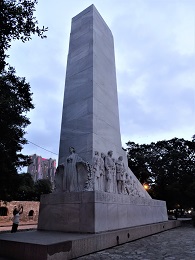 This is also known as The Spirit of Sacrifice and is a monument that was erected in 1939 and is dedicated to those who gave their lives in 1836. The names of the known defenders are displayed on the Cenotaph. On the other side of the Plaza opposite the missionary are the ruins of a number of buildings which give an indication of the size of the compound. 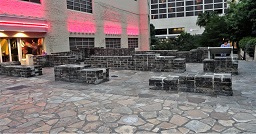 A visit to the Alamo starts at the front of the mission, an area which was originally bordered to the north by the south wall of the Convento and to the west by a portion of the compound walls. This area served as a cemetery or “campo santo” during the mission period. The building is now the Shrine or Chapel. This is dedicated to the memory of the men who died defending the mission. Originally this was intended as the mission church in the 1700s but was not finished when the mission closed in 1793. The concrete barrel vault was completed in 1921, with sections of concrete being added to the tops of the walls to create the parapets. The area in front of the mission is known as the palisade and is where, according to legend, Travis drew a line in the sand asking volunteers to cross in order to stay and fight. It is believed only one man did not cross the line and left the Alamo. It is also the place where Davy Crockett is believed to have died. 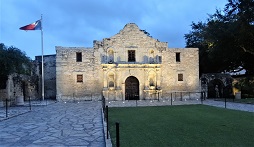 On the left of the palisade is the entrance to the Convento Courtyard which was originally the residence of the Spanish missionary priests. Within the courtyard are a large oak tree and the original Spanish well. 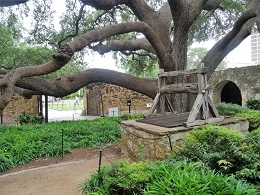 On the left is the Long Barracks which contains a small museum with paintings, weapons, and other artifacts which are connected to the site's past. Items such as the sword of Colonel Travis, the rifle of Davy Crockett, and a couple of knives of Jim Bowie, as well as numerous other personal possessions are displayed there. Photographs here or in the shrine/chapel are not permitted without a permit. The Long Barracks It was the site of some of the fiercest fighting in the 1836 Battle of the Alamo when many members of the garrison withdrew into this building where they made a last stand. On exiting the Long Barracks, the path leads round to the Cavalry Courtyard. This was where livestock was held during the siege. Today it contains the flags which have flown over Texas during its history. It is also the place where talks on the history of the Alamo are given throughout the day. 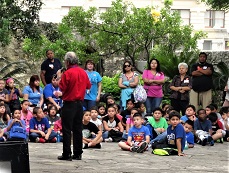 Adjoining the courtyard is the Wall of History, this consists of 5 panels detailing the history through the periods related to the history of the Alamo, and adjacent to that is the gift shop. Although it complements the architectural design of the other buildings, this was built in 1936, it was renovated in 2012. 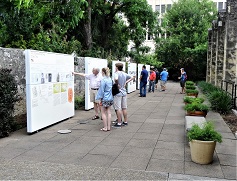 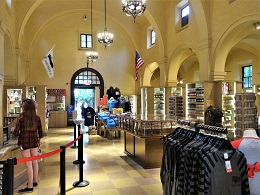 There are additional buildings that are not normally open to the public. The Alamo Hall, which was built in 1922 was once a San Antonio fire station this is now used as a meeting room and can be hired for functions. Next to that is the Research Centre, which contains books, documents, and photographs related to the history of Texas. Built in 1950, this was formerly known as the Daughters of the Republic of Texas Library. It is located just outside is a fountain and sitting area and access is by appointment only. 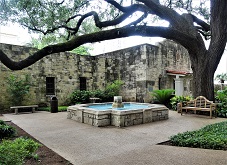 The stone walls and arcades that surround the Alamo were erected in the 1920s. The whole site is tastefully presented and not over-commercialised, and no charge is made for entry. To see more photographs and take a virtual tour of the site click on the photoshow below.
|
|
|
|
|
|||
All Photographs were taken by and are copyright of Ron Gatepain
| Site Map |
